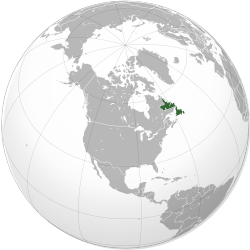Dominion of Newfoundland
| Newfoundland | ||||||||||||
| Dominion | ||||||||||||
|
||||||||||||
|
||||||||||||
|
Motto Quaerite Prime Regnum Dei (Latin) "Seek ye first the kingdom of God" |
||||||||||||
|
Anthem Ode to Newfoundland |
||||||||||||
| Capital | St. John's | |||||||||||
| Languages | ||||||||||||
| Government | Constitutional monarchy | |||||||||||
| King | ||||||||||||
| • | 1907-1910 | Edward VII (first) | ||||||||||
| • | 1936-1949 | George VI (last) | ||||||||||
| Governor | ||||||||||||
| • | 1907-1909 | William MacGregor (first) | ||||||||||
| • | 1946-1949 | Gordon Macdonald (last) | ||||||||||
| Prime Minister | ||||||||||||
| • | 1907-1910 | Robert Bond (first) | ||||||||||
| • | 1932-1934 | Frederick C. Alderdice (last) | ||||||||||
| Legislature | House of Assembly | |||||||||||
| Historical era | World War I Interwar period World War II |
|||||||||||
| • | Semi-independent Dominion | 26 September 1907 | ||||||||||
| • | Fully sovereign Dominion (Statute of Westminster 1931) |
11 December 1931 | ||||||||||
| • | British Dominion-dependency (Commission of Government) |
16 February 1934 | ||||||||||
| • | Province of Canada (Newfoundland Act) |
31 March 1949 | ||||||||||
| Currency | Newfoundland dollar | |||||||||||
|
||||||||||||
| Today part of |
|
|||||||||||
1de facto, in 1934, Newfoundland gave up self-rule, but remained a de jure independent dominion until it joined Canada in 1949.
|
||||||||||||
Newfoundland was a British dominion from 1907 to 1949. The dominion was situated in northeastern North America along the Atlantic coast and comprised the island of Newfoundland and Labrador on the continental mainland. Before attaining dominion status, Newfoundland was a British colony, self-governing from 1855.
Newfoundland was one of the original "dominions" within the meaning of the Statute of Westminster of 1931 and accordingly enjoyed a constitutional status equivalent to the other dominions at the time. In 1934, Newfoundland became the only dominion to give up its self-governing status, ending 79 years of self-government.
This episode was precipitated by a crisis in Newfoundland's public finances in 1932. Newfoundland had accumulated a significant amount of debt by building a railroad across the island and raising its own regiment for the First World War. In November of that year, the government warned that Newfoundland would default on payments on the public debt. The United Kingdom government quickly established the Newfoundland Royal Commission to inquire and report on the position. The Commission's report was published in October 1933. It recommended that Newfoundland give up its system of self-government temporarily, and allow the United Kingdom to administer the dominion through an appointed commission.
The Newfoundland parliament accepted this recommendation and presented a petition to the King asking for the suspension of the constitution and the appointment of commissioners to administer the government until the country became self-supporting again. To enable compliance with this request, the United Kingdom Parliament passed the Newfoundland Act 1933, and on 16 February 1934, the UK government appointed six commissioners, three from Newfoundland and three from the UK, with the Governor as chairman. The dominion was never to be self-governing again. The system of a six-member Commission of Government continued to govern Newfoundland until it joined Canada in 1949 to become Canada's tenth province.
...
Wikipedia



